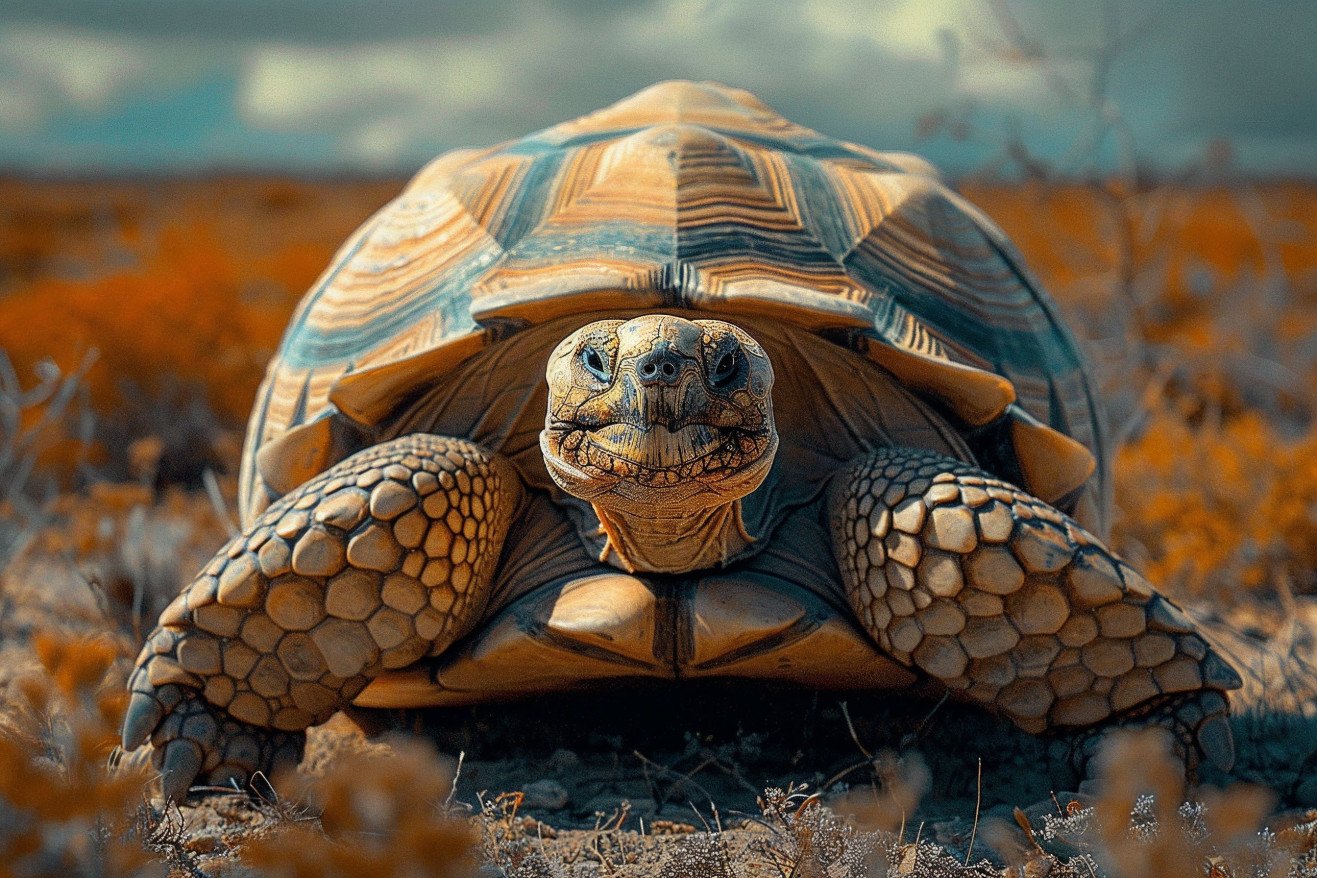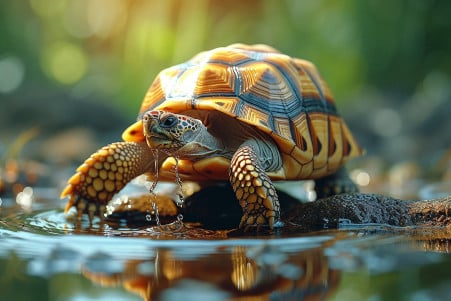Sulcata Tortoise Size: How Large Can These Giants Grow?
31 May 2024 • Updated 29 May 2024

How big do sulcata tortoises really get, and what determines their maximum size? As African spurred tortoises, the third largest tortoise species in the world, sulcata tortoises can grow to be quite large - over 2.5 feet long and 100-200 pounds as adults in captivity.
This article will review scientific studies by herpetologists and other tortoise researchers that have investigated the optimal environmental conditions, diet, and growth rates that lead to the maximum size of sulcata tortoises in the wild and in captivity. This will help owners better understand what impacts their growth so they can make sure that their tortoises reach their full, impressive size while also making sure that they're properly cared for.
How large can Sulcata tortoises grow?
The Best Habitat for Giant Sulcata Tortoises
Sulcata tortoises are from the Sahara Desert and Sahel region of northern Africa, where the landscape is made up of arid grasslands, scrublands, and savannas, says The Maryland Zoo. In order to grow to their full potential, these reptiles need to be in an environment that is as close to their natural habitat as possible.
Sulcatas need to be in a hot, dry environment with temperatures that range from 80-95°F and a basking area that is around 100°F. This will help them thermoregulate. They also need to be in an environment with loose, well-drained soil that is at least 6-12 inches deep so that they can burrow, which is an important way that they can protect themselves from the extreme heat and predators of the desert. They also need to have access to shelters like heated sheds or humid hides.
Since they are grazers, sulcata tortoises need to be in an environment that has a lot of space and includes grassy areas where they can graze. Reptile Rapture suggests that an outdoor enclosure should be as large as possible, and for adults, it could even be an entire backyard. This will give them the opportunity to walk the miles that they would in the wild and will help them get the exercise that they need to grow strong muscles and bones.
If you can provide the key elements of their Saharan homeland, including the right temperatures, substrate, space, and grazing areas, then you can make sure that these tortoises have everything that they need to grow to be the third-largest tortoise species in the world. If you can't provide these things, then their growth will be stunted.
The Sulcata Tortoise Growth Cycle: From Baby to Giant Tortoise
The growth cycle of the sulcata tortoise is one of the most amazing things about this species. According to Tortoise Town, the growth cycle can be broken down into four stages: hatchling, juvenile, subadult, and adult.
Sulcatas grow quickly in the first 5-7 years, with 7-year-old sulcatas being over half the size of an adult, according to Hepper. Growth slows down after that, but it continues at a steady pace until they reach sexual maturity at 10-15 years old. Most sulcatas will have reached their full adult size of 18-30 inches and 75-150 lbs by the time they are 15-25 years old, at which point they will stop growing, according to CB Reptile.
To reach their full size, it’s important that these tortoises are cared for properly in each stage of their growth cycle. Making sure they have the right environment to grow is important, as poor living conditions can stunt their growth.
Diet and Nutrition for Growth
A well-rounded, plant-based diet is needed to support the rapid growth and maximum size of sulcata tortoises, explains ReptiFiles. Hatchlings need higher protein levels from grasses, weeds, and leafy greens to help them grow. As adults, sulcatas are grazers and need a constant supply of fresh grasses, hay, and other vegetables.
Calcium, vitamin, and mineral supplements are also needed, especially for breeding females, according to Arizona Exotics. Diets that don’t include these supplements can lead to growth issues that prevent sulcatas from reaching their full size, which can be more than 30 inches and 200 pounds, according to Tortoise Supply.
Making sure that the right diet is provided at each stage of life is one of the most important factors in ensuring that these tortoises grow to their full adult size. However, even with the right diet, there are still other issues that sulcatas face in captivity that can affect their growth.
Difficulties of Keeping and Housing Sulcata Tortoises
Sulcata tortoises need a lot of space, and they can grow to be very large, so outdoor housing is often necessary, according to Reptiles Magazine. It can be challenging to create the right hot, dry environment with the correct substrate and temperature requirements. Sulcatas need an ambient temperature between 80-95°F with a basking spot of 100°F, according to Reptile Rapture. Their size and strength also mean they can do a lot of damage if they're kept indoors, so that's another hurdle for owners.
On top of that, sulcata tortoises live a very long time, with a lifespan of 70-100 years, so they require a long-term commitment, according to The Spruce Pets. Many of them are surrendered because their owners didn't realize how big they would get and how much care they would need. They can grow to be over 30 inches long and weigh over 200 pounds, according to A-Z Animals. That's why it's so important for people to make sure they're ready to take on the responsibility of caring for one of these gentle giants.
Conservation Efforts for the Vulnerable Sulcata Tortoise
The sulcata tortoise is listed as Vulnerable by the International Union for Conservation of Nature (IUCN) due to decreasing wild populations, per the Oregon Zoo. Their populations are threatened by habitat loss due to overgrazing, poaching for the pet trade, and hunting for food. A study in Oryx found a strong negative relationship between grazing intensity and the presence of sulcata tortoises.
Conservation efforts work to protect sulcatas and their habitats, like the one led by Soptom in Senegal's Ferlo biosphere reserve, which is described by Fondation Ensemble. Reintroduction programs and anti-poaching patrols have been shown to be effective in helping to stabilize wild populations. People can also make a difference by making ethical choices, such as not purchasing products made from real tortoiseshell, which contributes to the illegal wildlife trade that threatens these animals, according to the Oregon Zoo and World Wildlife Fund.
Conclusion: Understanding the Gentle Giants of the Reptile World
Sulcata tortoises are one of the largest tortoise species in the world and can grow to truly impressive sizes. According to ReptiFiles, fully grown males can grow to be over 30 inches long and weigh more than 200 pounds in captivity, while females can grow to be about 24 inches long and weigh about 100 pounds.
This incredible growth is supported by a specialized diet and living conditions that mimic the hot, dry environment of the Sahara Desert and Sahel region, the native home of these tortoises. As noted by The Maryland Zoo, sulcatas need to be kept in an environment with temperatures between 80-95°F and have access to shelters and burrows to escape the heat of the desert.
It’s essential to provide the right living conditions, diet, and care to help sulcata tortoises grow to their full potential. However, as pointed out by The Spruce Pets, their large size and long lifespan, which can be up to 100 years, make them a challenging pet for many people. Unfortunately, many sulcatas are given up for adoption when their owners realize they can’t meet the needs of an adult tortoise.
Despite these issues, conservation efforts are underway to help save the wild sulcata population, which is listed as Vulnerable by the IUCN due to threats like habitat destruction and the illegal pet trade, according to the Oregon Zoo. With the right information and dedication, sulcata tortoises can be kept in captivity for many years, allowing more people to learn about and enjoy their impressive size and natural history.


